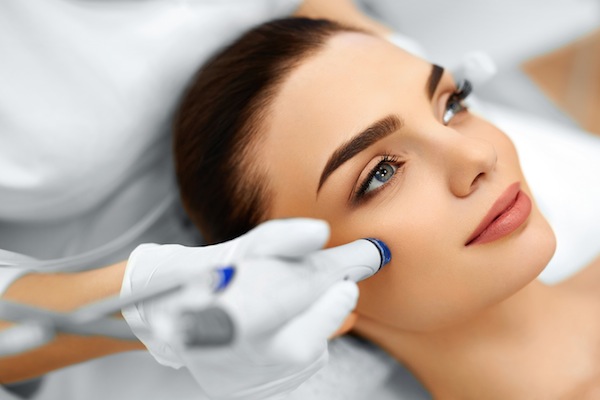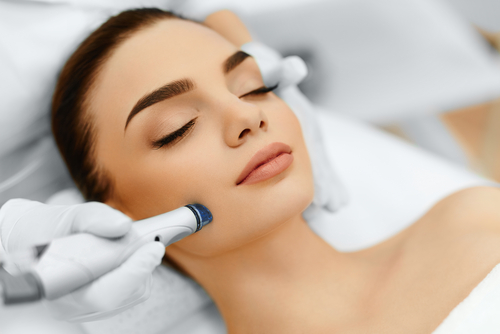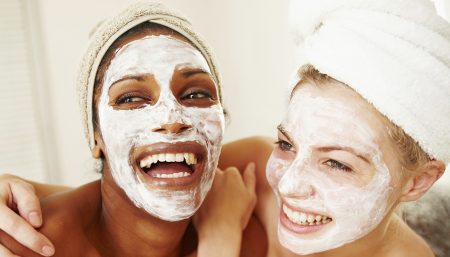Microdermabrasion is one of the more recent skin-care techniques to have crossed over from Hollywood to the mainstream. It’s being advanced as an “instant facelift” — an effective alternative to costlier and more invasive procedures like plastic surgery, chemical peels and Botox injections.

Microdermabrasion is a general term for the application of tiny rough grains to buff away the surface layer of skin. Many different products and treatments use this method, including medical procedures, salon treatments and creams and scrubs that you apply yourself at home. It’s usually done to the face, chest, neck, arms or hands. Before we can understand how microdermabrasion does what it does, it’s important to understand how skin works.
Your skin is made up of two main layers, the epidermis and the dermis. The epidermis is the layer closest to the outside world. It’s a set of dead skin cells on top of another layer of cells that are in the process of maturing. The topmost layer is called the stratum corneum. The stratum corneum mostly acts as a barrier between the outside world and the lower skin layers. It keeps all but the smallest molecules from getting through.
When you put lotions or creams on your skin, some of the moisture passes through the stratum corneum, but not all of it. This layer is home to many minor skin imperfections like fine wrinkle lines and blemishes. All of the action in microdermabrasion takes place at the level of the stratum corneum. Since it only really targets the epidermis (and not the dermis), it is more accurate to call it micro-epi-dermabrasion. Affecting deeper layers of skin would be painful and harmful, and it would risk permanently embedding the tiny grains into the skin.
Microdermabrasion is a light cosmetic procedure that uses a mechanical medium for exfoliation to gently remove the outermost layer of dead skin cells from the epidermis. Most commonly, microdermabrasion uses two parts: an exfoliating material like crystals or diamond flakes and a machine based suction to gently lift up the skin during exfoliation. It is a non-invasive procedure and may be performed in-office by a trained skin care professional.
It may also be performed at home using a variety of products which are designed to mechanically exfoliate the skin. Many salon machines and home-use machines use adjustable suction to improve the efficacy of the abrasion tool. Recently, cosmetic scrub products that contain fine grit made from the pits of various fruits and from other materials are using the term microdermabrasion in their marketing.
Microdermabrasion is a fairly simple, easy, painless, non-invasive, skin rejuvenation procedure using a combination of a fine abrasive tip or crystals and vacuum suction applied to the skin. Typically there are no needles or anesthetics required for microdermabrasion. The vacuum pressure and speed are adjusted depending on the sensitivity and tolerance of the skin. Microdermabrasion is often compared to the feeling of a cat licking the skin- a rough but gentle texture. Typical microdermabrasion sessions can last anywhere from 5–60 minutes.
Minimal to no recovery time is required after microdermabrasion and most people immediately return to daily activity after a session. Makeup and non-irritating creams can usually be applied within a few hours or right after microdermabrasion. Since there is an often immediate increased minor skin sensitivity after microdermabrasion, irritating products like glycolic acids, Alpha Hydroxy Acids, Retinoid products or fragranced creams and lotions are typically avoided right after the procedure.
Traditionally, crystal microdermabrasion system contains a pump, a connecting tube, a hand piece, and a vacuum source. While the pump creates a high-pressure stream of inert crystals, such as aluminum oxide, magnesium oxide, sodium chloride, and sodium bicarbonate, to abrade the skin, the vacuum removes the crystals and exfoliated skin cells. Alternatively, the inert crystals can be replaced by a roughened surface of the tip in the diamond microdermabrasion system.
Unlike the older crystal microdermabrasion system, the diamond microdermabrasion does not produce particles from crystals that may be inhaled into patients’ nose or blown into the eyes. Hence, diamond microdermabrasion is regarded as having higher safety for use on areas around the eyes and lips. Generally, the slower the movement of the microdermabrasion handpiece against the skin and the greater the numbers of passes over the skin, the deeper the skin treatment.
Often called “microderm” for short, microdermabrasion is a procedure to help exfoliate or temporarily remove a few of the top layers of the skin called the stratum corneum. Much like brushing one’s teeth, microdermabrasion helps to gently remove skin “plaque” and skin debris. Since human skin typically regenerates at approximately 30 day intervals, skin improvement with microdermabrasion is temporary and needs to be repeated at average intervals of two – four weeks for continued improvement. Multiple treatments in combination with sunscreen, sun avoidance, and other skin care creams yield best results.
Dermabrasion is generally used to refer to a true surgical procedure that aggressively abrades away the top to mid layers of the skin. The term microdermabrasion generally refers to a non-surgical procedure that abrades less deeply than dermabrasion. Although the mechanism of the two procedures is similar, the difference in the depth of the abrasion results in different recovery times. Dermabrasion recovery time may take as much as several weeks to several months whereas microdermabrasion recovery time may be as little as one to two days. After microdermabrasion, skin will be much more sensitive to sun exposure. It is best to keep out of the sun and wear sunscreen at all times after the procedure.
Microdermabrasion may be performed to help diminish the appearance of superficial hyperpigmentation, and photo-damage, as well as diminish fine lines, wrinkles, acne, and shallow acne scars. A further benefit of microdermabrasion is enhanced skin penetration by other skin creams and serums. Removing dead skin (startum corneum of the epidermis) will aid in the penetration of skin care products and medications by up to 10-50%. The controlled skin exfoliation afforded by microdermabrasion will afford make-up and self-tanning products to go on much more smoothly.
Microdermabrasion treatment carries minimal to very few possible side effects or complications. However, some patients may experience temporary mild dryness, sun sensitivity, and rarely temporary bruising or scratches in the area of skin treated.
Microdermabrasion units
The first microdermabrasion unit was developed in Italy in 1985, using small inert aluminium oxide crystals to abrade the skin. In 1986, other European markets had introduced the technology, which was immediately adopted by physicians for mechanical exfoliation. There were 10 microdermabrasion units on the market in Europe by the end of 1992. In 1996, Mattioli Engineering partnered with one of the Italian designed machines and started working towards meeting FDA requirements for the USA. By the end of 1996, the FDA issued the first approval letter for microdermabrasion machines. In January 1997, the first microderm machine was being sold and marketed in the US. The diamond tip was introduced in 1999 and the bristle tip brush was introduced in 2005.
The first standard vacuum based microdermabrasion system called Vacubrasion was introduced in 2012 in the U.S. and world markets, and provides diamond tip exfoliation and suction. Vacubrasion’s patented air regulator delivery system was designed and underwent extensive testing by U.S. dermatologists and physicians. Its straightforward design revolutionized microdermabrasion to permit use of almost any type of suction source (primarily retail brand vacuums with a 1.25 inch standard round hose such as Eureka, Stanley vacuums) with a non-disposable, attached electroplated fine diamond abrasive tip. While traditional, older crystal based microdermabrasion and home microdermabrasion systems are not infrequently fraught with clogging issues and potential loss of suction,the crystal-free Vacubrasion systems utilize a universal, larger and more powerful suction source that avoids many of these issues.
Abrasive material
Microdermabrasion has evolved from rocks, stones and shells to crystals, particle-free diamond tips and particle-free bristle tips. Once the desired amount of exfoliation has been reached, some microdermabrasion units will then spray or infuse a skin enhancing solution into the skin. Since microderm essentially manually removes limited layers of the stratum corneum (dead layers of the outer layer of the skin), any serum or topical product applied in any fashion to the skin following microdermabrasion will potentially have a greater opportunity for penetration into the skin.

Microdermabrasion crystals are typically made of a very fine, abrasive material like aluminum oxide. Other inert microderm crystals include magnesium oxide, sodium chloride, and sodium bicarbonate. All ultra-fine white crystals are disposable and should be discarded after each use. The microdermabrasion vacuum removes the crystals and exfoliated skin cells. Inhalation of crystals should be avoided and masks are sometimes worn by the operator doing the treatment. Ocular injury may occur if crystals are inadvertently sprayed in the eye or if crystals remain around the eye and cause a corneal abrasion. There are some possible concerns of inhalation exposure and basic safety precautions should be taken. Patient goggles or eye shields, as well as operator face masks are recommended when treating with crystal based systems. Alternatively, microderm crystals can be safely replaced by the roughened surface of a diamond tip microdermabrasion system.The newer diamond based systems like Vacubrasion utilize a fine diamond dust that is essentially electroplated onto a stainless steel round tip that comes in contact with the skin.
Microdermabrasion media
Aluminium oxide crystals: 100 micrometres; aluminium oxide is relatively chemically inert and generally recognized as safe.
Bristle tips: bristles are pliable, so they move with the skin allowing for aggressive treatments without added irritation.
Diamond tips: can be natural but usually synthetic for lower costs; erythema (Redness) is partially due to circulation rather than only irritation.
Liquid: water based sprays in combination with a rough plastic tip spray liquid against the skin to help gently exfoliate.
Magnesium oxide
Organic grains: used to buff and polish; made from trees, plants, agricultural crops, straw, reeds, maize, sunflower, cane sugar.
Sodium bicarbonate & sodium chloride crystals.
Microdermabrasion works especially well as a way to clean out clogged pores. It’s a useful alternative for patients whose skin is too sensitive to use anti-acne drugs like Retin-A. It’s not recommended for those who have active oral herpes. Here’s a list of the conditions that make someone unsuited for microdermabrasion: Active rosacea, Fragile capillaries ,Vascular lesions, Widespread acne, Herpetic lesions (herpes), Warts, Open sores, Skin lesions, Anyone who takes anti-coagulants, Eczema, Dermatitis, Psoriasis, Lupus, Erythematosus and Diabetes mellitus.
Disclaimer
The Content is not intended to be a substitute for professional medical advice, diagnosis, or treatment. Always seek the advice of your physician or other qualified health provider with any questions you may have regarding a medical condition.
